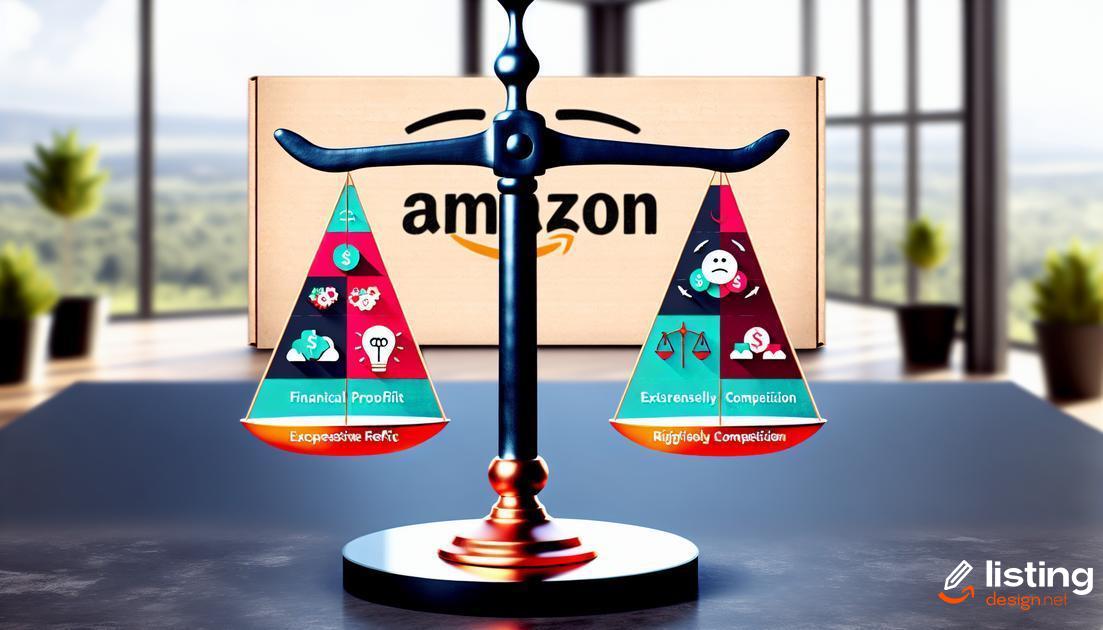Deciding whether to sell on Amazon can be daunting. Is selling on Amazon worth it for your business? This guide covers the key benefits, challenges, and costs to help you make an informed choice. Learn how Amazon’s marketplace operates and get tips for achieving success. Explore alternatives and read real seller experiences to determine if Amazon is the right platform for you.
Table of Contents
The Benefits of Selling on Amazon
Exposure to a Global Audience: Selling on Amazon gives you access to millions of potential buyers worldwide. Amazon’s vast customer base can significantly boost your product’s visibility.
Prime Membership Benefits: Many Amazon customers are Prime members, who actively seek products available for Prime shipping. By selling on Amazon, your products can be more appealing to these buyers.
Fulfillment by Amazon (FBA): Amazon’s FBA service handles storage, shipping, and customer service. This can save you time and logistics costs, allowing you to focus on growing your business.
Trust and Credibility: Amazon’s reputation for reliability can lend credibility to your products. Consumers often trust and prefer buying from Amazon, owing to its robust return policies and customer service.
Boosted Sales Potential:
With Amazon’s advanced recommendation algorithms, your products can show up as suggested items, increasing the likelihood of sales from related purchases.
Simple and Effective Marketing Tools: Amazon offers several promotional tools like sponsored ads and deals. These tools can help drive traffic to your listings and increase sales.
Insights and Analytics: Access to detailed analytics and reporting can help you understand your sales performance and customer behavior, enabling better strategic decisions.
The Challenges of Selling on Amazon

Selling on Amazon can be incredibly lucrative, but it comes with its own set of challenges. One of the significant hurdles is the intense competition. With millions of sellers offering similar products, standing out can be difficult. Many sellers invest heavily in advertising and promotion just to gain visibility.
Another challenge is dealing with Amazon’s complex rules and regulations. Violating any of these policies can result in suspension or even termination of your account. It’s essential to stay updated with Amazon’s guidelines to avoid potential pitfalls.
The fees associated with selling on Amazon can also be a burden. From referral fees to fulfillment fees, the costs can add up quickly, affecting your profitability. Understanding and managing these expenses is crucial for maintaining a healthy profit margin.
Additionally, customer reviews and feedback can significantly impact your sales. Negative reviews can deter potential buyers, so it’s important to provide high-quality products and excellent customer service to maintain positive feedback.
Lastly, there’s the issue of inventory management. Keeping track of stock levels, handling returns, and ensuring timely delivery can be challenging, especially for small businesses. Using inventory management tools can help streamline these processes and reduce stress.
Cost Analysis: Fees and Expenses
When selling on Amazon, it’s crucial to understand the various fees and expenses associated with the platform to effectively manage your profit margins. One of the primary costs is the referral fee, which varies by category but generally ranges from 6% to 45% of the product’s selling price.
Fulfillment by Amazon (FBA) Fees
FBA offers convenience as Amazon handles storage, packaging, and shipping, but it comes at a cost. These fees include monthly storage fees and fulfillment fees based on the product’s size and weight.
Monthly Subscription Fee
If you opt for a Professional Seller account, there’s a fixed monthly fee of $39.99, which can be a worthwhile investment if you sell in high volumes.
Other Costs
Additional expenses might include costs for returns processing, advertising fees if you use Amazon’s PPC (Pay-Per-Click) ads, and long-term storage fees for inventory that remains unsold for over a year. Understanding these expenses can help you price your products appropriately and ensure profitability.
Understanding Amazon’s Marketplace

Amazon’s marketplace is a vast ecosystem that connects millions of sellers with countless buyers worldwide. This structure presents unique opportunities and challenges. Sellers need to understand how Amazon’s algorithms work and how to optimize their listings for better visibility.
Product Listings: Crafting the perfect product listing is crucial. This involves writing detailed and keyword-optimized product descriptions, high-quality images, and utilizing bullet points to highlight key features.
Fulfillment Options: Sellers can choose between Fulfillment by Amazon (FBA) or Fulfillment by Merchant (FBM). FBA offers convenience and Prime eligibility, while FBM provides more control over the shipping process.
Customer Reviews: Reviews significantly influence purchasing decisions. Encouraging satisfied customers to leave positive reviews can boost a product’s ranking and credibility.
Advertising Tools: Amazon provides a variety of advertising options, from Sponsored Products to Display Ads. These tools can help increase product visibility and drive sales.
Understanding these elements and leveraging them effectively can make a significant difference in a seller’s success on Amazon’s marketplace. It’s essential to stay informed about policy changes and market trends to maintain a competitive edge.
Tips for Successful Selling
Start by ensuring your product listings are optimized. Use high-quality images and write detailed product descriptions with relevant keywords. This increases visibility and attracts more potential buyers.
Pay attention to customer reviews. Respond promptly to feedback and resolve any issues quickly.
Positive reviews
can significantly impact your sales.
Competitive pricing is crucial. Regularly monitor your competitors and adjust your prices accordingly to stay attractive. Be cautious about pricing too low, as it may affect your profitability.
Leverage Amazon’s advertising tools to boost product visibility. Sponsored Products and Sponsored Brands can help you reach a wider audience.
Maintain adequate inventory levels. Running out of stock can hurt your search rankings and lead to missed sales opportunities. Use Amazon’s inventory management tools for better control.
Understand and utilize Amazon FBA (Fulfillment by Amazon). It can streamline the shipping process and offer customers faster, more reliable delivery options. This leads to higher customer satisfaction and better sales performance.
Lastly, constantly analyze your metrics. Use Amazon’s performance reports to identify trends and make informed decisions on product listings, pricing, and inventory management.
Alternatives to Amazon

While Amazon is a popular platform for many sellers, it’s not the only option available. Here are some alternative marketplaces that might suit your business needs better:
eBay
eBay has been around since the mid-’90s and offers a diverse customer base. Sellers can list individual items through auction or ‘Buy It Now’ options, giving you flexibility in how you sell your products.
Etsy
Etsy is ideal for selling handmade, vintage items, and craft supplies. It’s a niche marketplace that attracts buyers looking for unique, personalized items, allowing sellers to reach a dedicated customer base.
Walmart Marketplace
The Walmart Marketplace allows third-party sellers to list products on Walmart’s website. This platform can give sellers access to Walmart’s vast, loyal customer base and extensive distribution network.
Shopify
Unlike marketplaces, Shopify allows you to create your custom online store. You have more control over your brand and customer experience. Though it requires more effort in terms of marketing and fulfillment, the autonomy can be worth it.
Newegg
Primarily focused on tech products, Newegg is known for its dedicated customer base looking for electronics, computer hardware, and related products. Sellers can benefit from its specialized audience.
Rakuten
Often referred to as the Amazon of Japan, Rakuten has a growing presence in global e-commerce. It offers various promotional tools and loyalty programs to help enhance your sales strategy.
Exploring these alternatives can diversify your sales channels and reduce dependency on Amazon, allowing for greater flexibility and resilience in your business model.
Case Studies: Real Seller Experiences
John’s Journey: John started his Amazon business in 2018, aiming to sell eco-friendly home products. Within six months, he managed to climb to the top 10% of sellers in his category. Regular feedback from customers helped him adjust his product listings and improve customer service. By 2020, John had seen a 30% increase in sales each quarter, attributing his success to Amazon’s Fulfillment by Amazon (FBA) program.
Susan’s Struggles: Unlike John, Susan faced significant hurdles. She entered the marketplace with handmade jewelry but struggled with exposure due to saturated categories. Despite investing in sponsored ads, her profit margins were impacted by high competition and associated costs. After two years, Susan decided to diversify her sales channels, reducing reliance on Amazon.
David’s Dual Approach: David took a different path by selling both on Amazon and his own website. He utilized Amazon to reach broader audiences but focused on his website for brand-specific promotions. This dual approach allowed him to maintain higher profit margins and build a loyal customer base. His experience demonstrates the advantage of not putting all eggs in one basket.
Linda’s Learning Curve: Linda launched her skincare line on Amazon, enticed by the platform’s vast reach. Though initial sales were slow, she took advantage of Amazon’s Seller University to refine her strategies. Gradually, her brand gained recognition, and Linda realized that continuous education and adaptation were key to overcoming market challenges.
Conclusion: Is It Right for You?

Selling on Amazon can offer numerous advantages including extensive reach and customer trust. However, it also presents certain challenges, such as high competition and fees. It’s essential to consider these factors before making a decision. Evaluating costs: Understand the fees and expenses involved to ensure profitability. Marketplace insights: Becoming familiar with Amazon’s policies and guidelines will help you navigate the platform effectively. Additionally, researching real-world experiences through case studies can provide valuable insights. Looking at alternatives might also reveal better options for specific products or niches. Use strategic planning and a clear understanding of the market to determine if selling on Amazon aligns with your business goals and capabilities.


